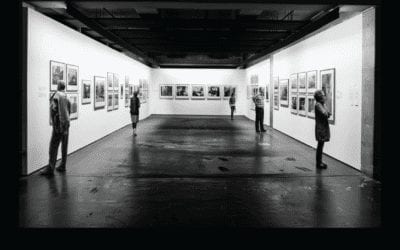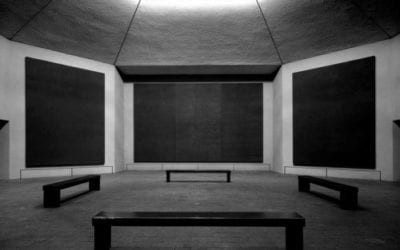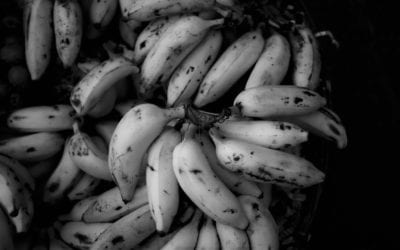Jeff Koons Top 5: $245 Million In Art
5) Popeye – $28,165,000
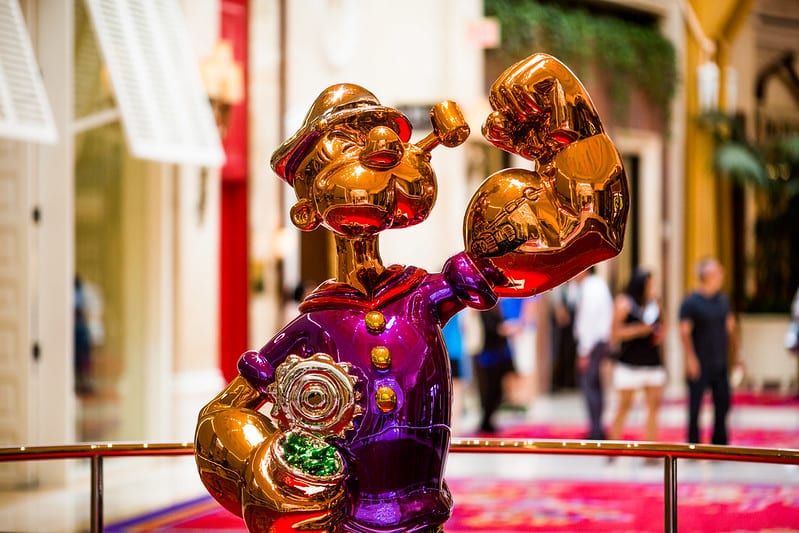
Popeye by Jeff Koons – Courtesy of Thomas Hawk / CC BY-NC 2.0
Medium: Mirror-Polished Stainless Steel With Transparent Color Coating
H x W x D : 78 x 51.75 x 28.5 inches
Year(s) Made: 2009 to 2011
Sale Date: May 13, 2014
Auction House: Sotheby’s
4) Tulips – $33,682,500
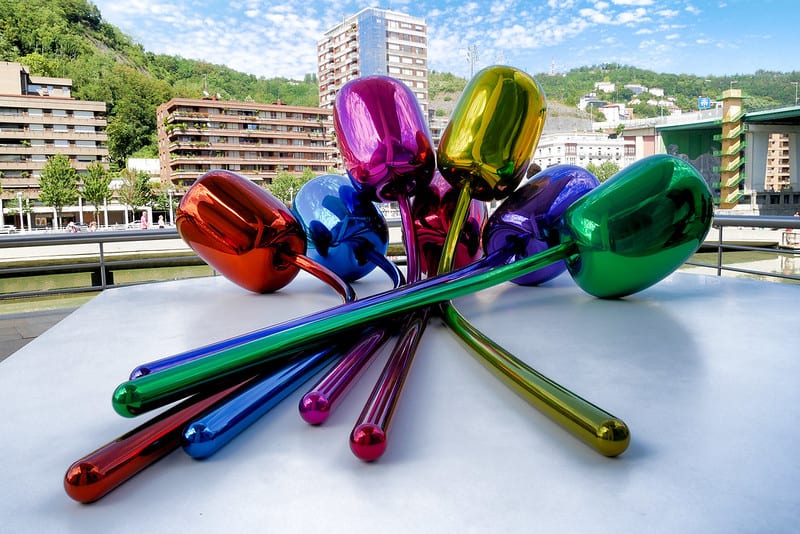
Tulips by Jeff Koons – Courtesy of Fred Romero / CC BY 2.0
Medium: Mirror-Polished Stainless Steel With Transparent Color Coating
H x W x D : 80 x 180 x 205 inches
Year(s) Made: 1995 to 2004
Sale Date: Nov 13, 2012
Auction House: Christie’s
3) Jim Beam – J.B. Turner Train – $33,765,000
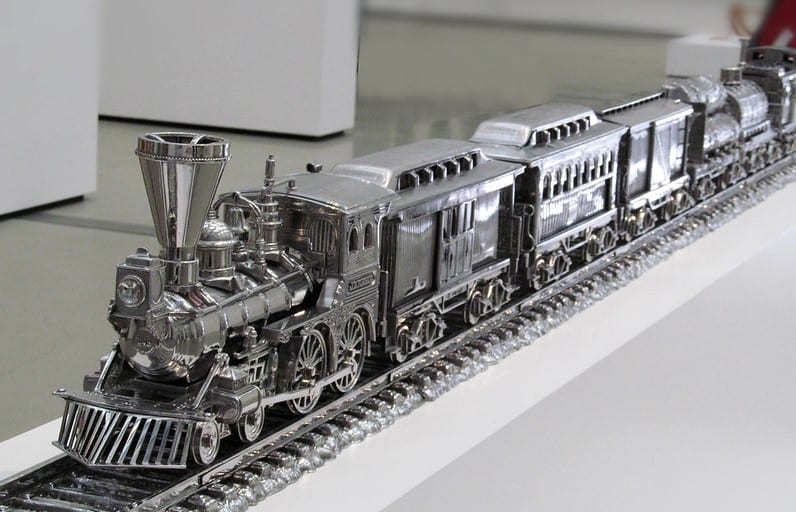
Jim Beam – J.B. Turner Train by Jeff Koons – Courtesy of Rocor / CC BY-NC 2.0
Medium: Stainless Steel, Bourbon
H x W x D : 11 x 114 x 6.5 inches
Year(s) Made: 1986
Sale Date: May 12, 2014
Auction House: Christie’s
2) Balloon Dog (Orange) – $58,405,000
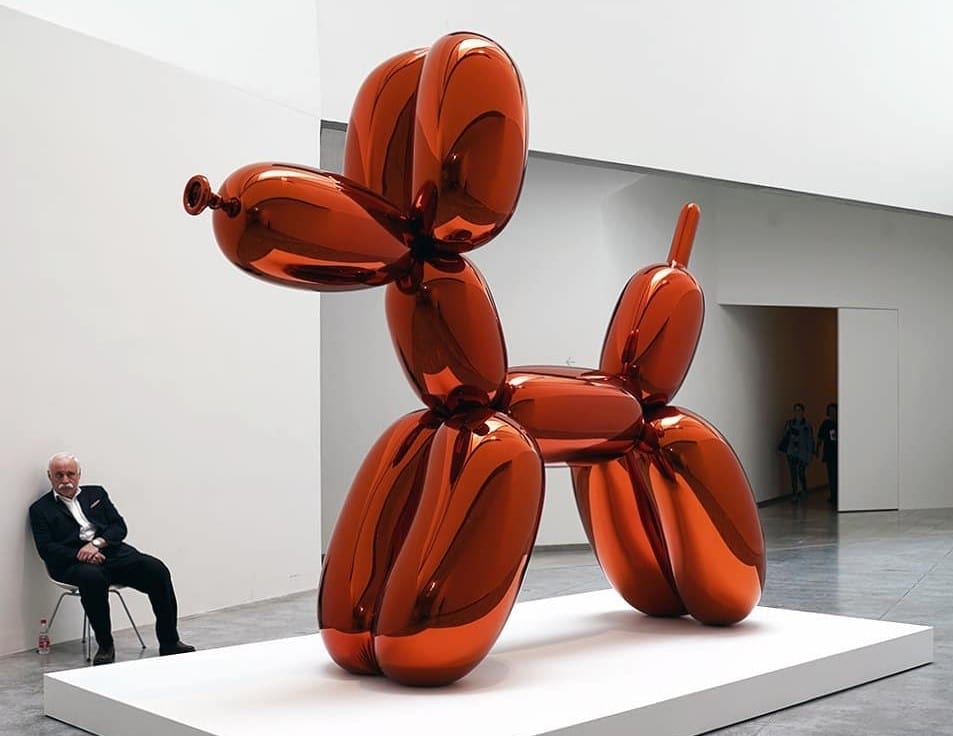
Balloon Dog (Orange) by Jeff Koons – Courtesy of Michal Bental
Medium: Mirror-Polished Stainless Steel With Transparent Color Coating
H x W x D : 121 x 143 x 45 inches
Year(s) Made: 1994 to 2000
Sale Date: Nov 11, 2013
Auction House: Christie’s
1) Rabbit – $91,075,000
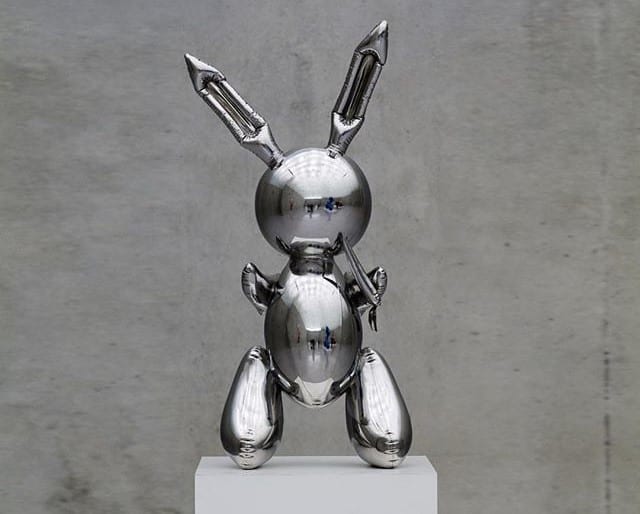
Rabbit by Jeff Koons – Courtesy of Vision Invisible / CC BY-NC-ND 2.0
Medium: Stainless Steel
H x W x D : 41 x 19 x 12 inches
Year(s) Made: 1986
Sale Date: May 14, 2019
Auction House: Christie’s
Style Themes
Enjoy. Don’t think.
Koons creates art to bring us joy. It doesn’t require special knowledge or have symbolic meaning. It simply asks, “Do you like it?” If so, it’s done its job.
Universal Subjects
Koons uses ordinary objects and recognizable figures as subjects in his art. He believes we subconsciously associate everything with specific feelings and thoughts such as skulls with death. He calls this the subject’s inner voice. Koons features subjects with happy or joyful voices like hearts or puppies. No matter our class or culture, these universal subjects have positive voices – creating judgment-free art. Art that can’t be misinterpreted as a statement, offensive, or discriminatory by anyone.
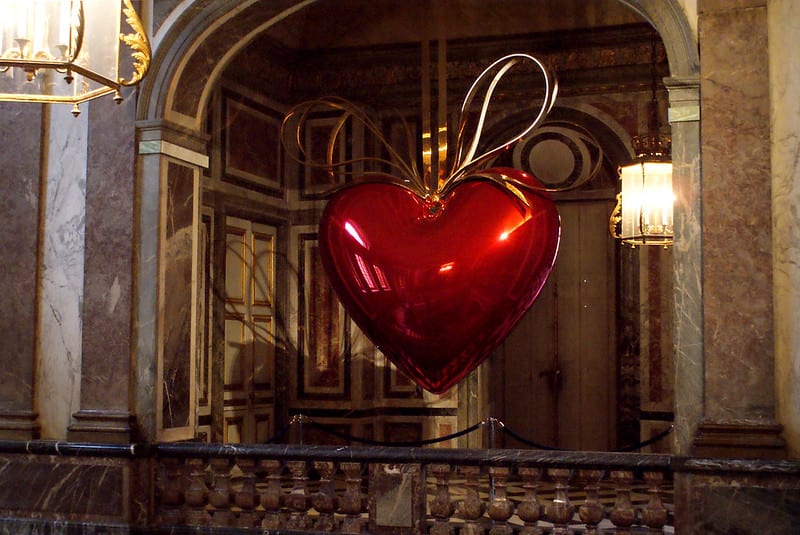
Hanging Heart by Jeff Koons – Courtesy of Marc Wathieu / CC BY-NC-ND 2.0
Enhanced Beauty
Visual impact is important to Koons. He seeks out subjects with natural aesthetic beauty and ponders them for years. He may see the beauty in the symmetry of a balloon or even the texture of a sponge. Finally, their beauty is enhanced by transforming their size or material and methodically staging them.
Interaction
Koons’s creations tempt us to come close, touch, or even play with them. Reflective surfaces bring our world into the art and lure us in. As we walk, it shimmers in the light and changes in appearance – creating an interactive experience. Another example, Splitrocker merges a rocking horse and dinosaur into a three-story sculpture covered in 90,000 live plants. Its greenery and nostalgic inner voice returns us to childhood and invites us in. Finally, entryways in the base allow us to venture through its inner soul.
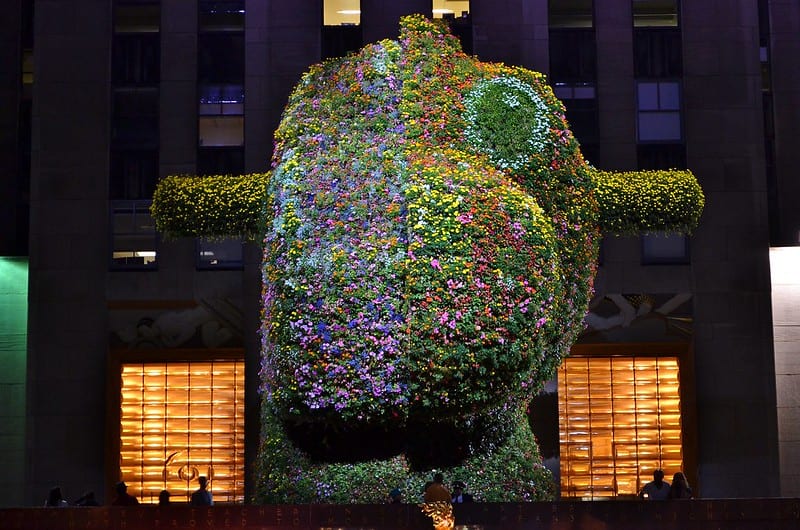
Splitrocker by Jeff Koons – Courtesy of Gigi NYC / CC BY-NC-ND 2.0
Desire & Acceptance
Koons makes art for us to accept and embrace our inner desires. And anything we love is a desire. They’re taboos like our cravings for luxury, sex, and status. They’re symbols of happiness like hearts and flowers. They’re even childhood memories society said were for kids like toys and balloons. He hopes that by accepting his art we grow to fully accept ourselves and others, who naturally share those desires with us.
Forever Prime
Many of us wish we could live life in our prime, at our hottest, richest, and happiest. Koons is fascinated by that and believes we’ll love a subject even more in its prime. So, he depicts Popeye after eating spinach and products fresh off the shelf. Most notably, we find the theme in his iconic mirror-polished stainless steel inflatables. Early on, Koons used ordinary plastic inflatables, but they deflated. Eventually, he transitioned to his iconic steel. The metallic “inflatables” never deflated. They were immortalized in their prime.
Common Critiques
It’s repetitive.
After seeing one piece, it feels like you’ve seen it all. Much of his work uses the same subjects, materials, and colors.
It’s unoriginal.
His work depends on subjects and images made by others. More importantly, he doesn’t do enough to enhance, alter, or transform them with his own artistic vision.
It’s meaningless.
In today’s art world, many believe art should stand for something. It should comment on society or give a new perspective. Koons’s art is intentionally meaningless.
It’s kitsch.
Kitsch refers to things made to be loved by the masses but are low-quality and distasteful. It’s the difference between a blockbuster action movie and an Oscar-winning film.
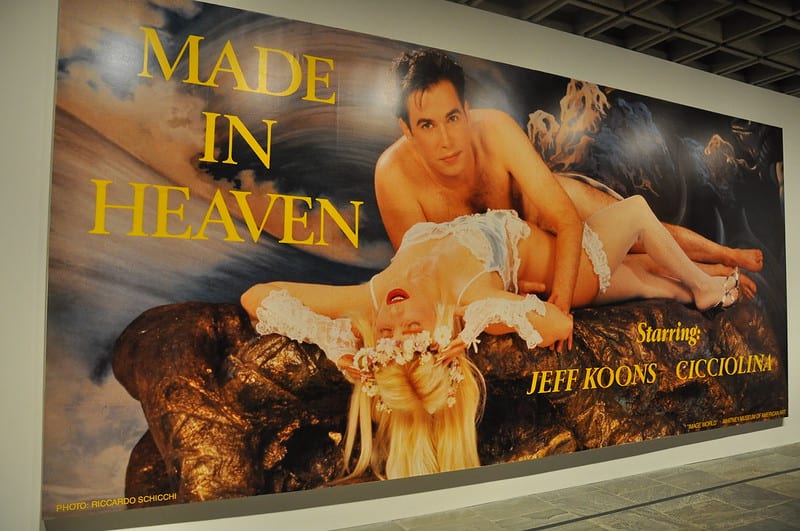
Made In Heaven by Jeff Koons – Courtesy of Amaury Laporte / CC BY-NC 2.0
Do You Like It?
Koons is an undeniable commercial success. But art is subjective, and despite his success, he’s surrounded by controversy. Is he a creative genius with a knack for finding universal desires and beauty in the mundane? Is he overpriced, unoriginal, and kitsch? Perhaps, it doesn’t matter. Koons makes art that doesn’t judge the world and asks the world not to judge it. It simply asks, “Do you like it?”
As I can,
ss
The Psychology of Interpretation
The Psychology of InterpretationSpace Program: Mars by Tom Sachs - Courtesy of Dave Pinter / CC BY-NC-ND 2.0Reliving Our PastAround 1917, psychologist Frederic Bartlett asked a group of participants to read and recite an unusual folk story, The War of the Ghosts...
How We Meet Black America
How We Meet Black AmericaRumors of War by Kehinde Wiley - Courtesy of Brecht Bug / CC BY-NC-ND 2.0Have we met before?In 2020, nearly everyone has an impression of Black America – good, bad, or indifferent. However, 40% of White Americans don’t have a single friend...
Retail vs. Fine Art: Do We Know the Difference?
Retail vs. Fine Art: Do We Know the Difference?Butterfly Knight by Oliver GalSelling vs. CreatingThe greatest separator between retail and fine art is philosophy. Retail art believes in selling. It’s for the newcomer looking for something beautiful. It wants to be...
Timeless Design: Reviewing Impulses by Dennis Dodson
Timeless Design: Reviewing Impulses by Dennis DodsonWhen a piece calls you, you know it. In 2016, while venturing through a labyrinth of 2,000+ pieces, one called me. Today, Impulses by Dennis Dodson towers over the rest of my collection. It’s intense yet subtle,...
12 Steps to Appreciating Art
12 Steps to Appreciating ArtUntitled No. 11, 1963 by Mark Rothko – Image Courtesy of Flickr / CC BY-NC-ND 2.0The Power of OpinionThe key to balancing subjectivity and judgment is our opinion. Opinions are interesting. They are unique to each of us yet we always have a...
Why No One Understands Abstract Art
Why No One Understands Abstract ArtSvanen (The Swan) No. 17 by Hilma Af Klint - Licensing (PD-old-75)Lost In the AbstractThe wilderness of abstract art is strange. Its colorful branches are incredibly unique yet strikingly similar – leaving us lost in the abstract....
Why A Banana is Worth $120K
Why a Banana is Worth $120KWhat’s special about Comedian?The banana’s name is Comedian. Don’t think of Comedian as a banana. Think about it as a comedian at a Sunday open mic. Every joke is about wealth inequality. And we’re all a part of it. Cattelan knew the...


